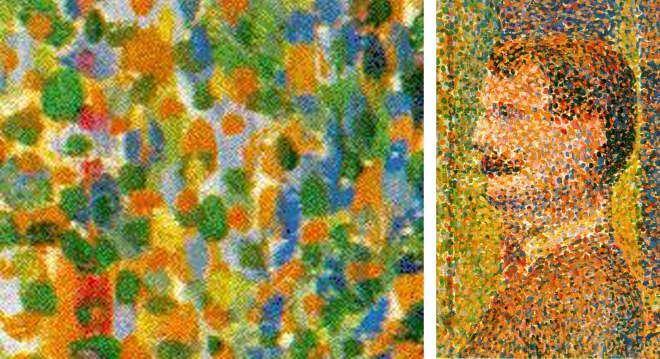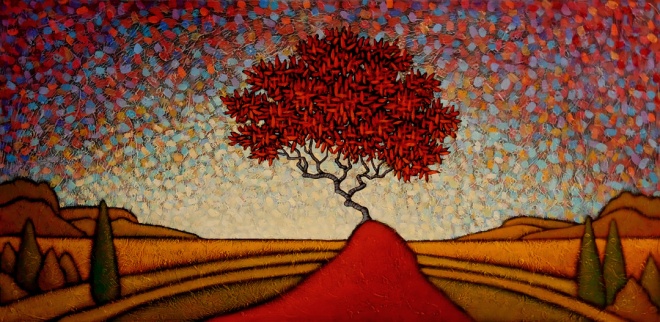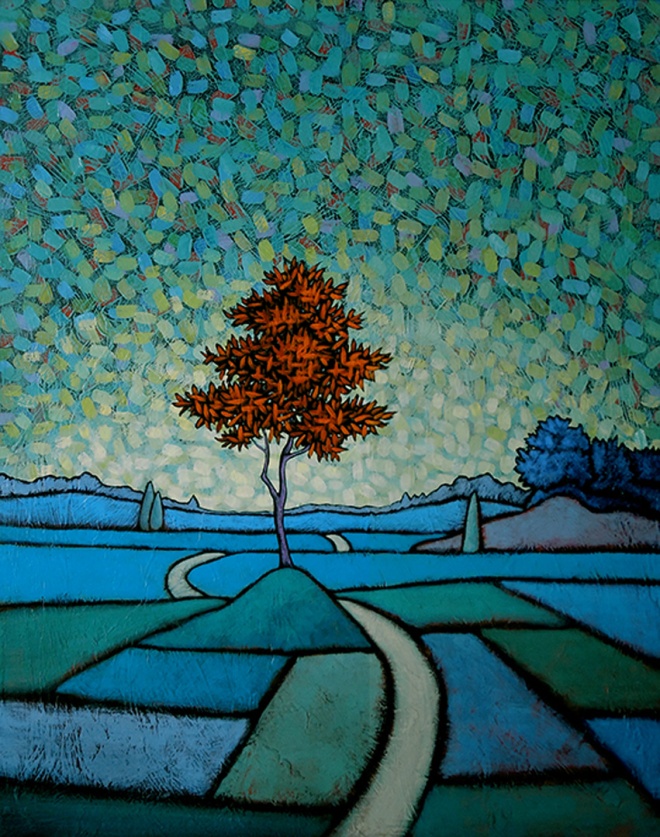Pointillism is a painting technique that popped up in the late 1800’s as an off-shoot of Impressionism. Essentially, pointillism uses small, distinct dots or strokes of different colors in a pattern to form an image. This technique relies on the ability of the eye to blend the dots of color–it’s actually quite similar to the way that computer screens and printers use tiny pixels of just a few colors (most printers have just four inks, CMYK) and posititions them all just right so that our eye blends them and sees a smooth image with normal-looking colors. So instead of mixing colors on a palette, the artist presents dots on the canvas that we mix with our eyes. To give you a very basic idea, here’s a visual example:
In the close-up detail on the left, you can see a wide variety of colors–yellow, orange, red, different shades of blue, and shades of green–but take a look at the upper left corner of the crop on the right. That’s where this close-up comes from. But, when we’re a bit further away, we see the dots begin to blend into a warm shade of green. And check out how blended everything becomes when we take another proverbial step back to look at the painting as a whole:
Examples from art history:
Fun fact: when I (Pam) was in the eighth grade, my art teacher taught us our first art history mnemonic device with the rhyme “Seurat knew a lot about dots.” Yes, indeed he did! Seurat’s “A Sunday Afternoon on the Island of La Grande Jatte” is probably one of the most well-known pointillist images ever:
Georges Seurat and Paul Signac were the original pioneers of the use of pointillism, referring to it as Neo-Impressionism. “Pointillism” was actually a derisive word coined by art critics, but the connotation of the word is no longer mocking. Many artists began to experiment with this technique, including Vincent Van Gogh, Camille Pissarro, and Maximilien Luce, among many others. Later, a group known as the Divisionists would tweak the idea by using larger, more square brushstrokes to create similar blended colors and patterns.

(left) Vincent van Gogh, Self-portrait; (middle) Paul Signac, “Le Clipper, Asnieres”; (right) Camille Pissarro, “Apple Picking at Eragny-sur-Epte”
Examples from Principle Gallery:
Several artists that we represent here at Principle Gallery occasionally dabble in pointillism in their works (check out the work of Mia Bergeron and Colin Fraser!), but one artist springs to mind in particular, with his classical and frequent use of the technique. GC Myers, whose annual solo exhibition opens THIS FRIDAY, has a knack for using pointillism to create a lovely and magical effect in the skies of many of his colorful landscapes. The dappled effect can give a sense of starlight, the glow of a sunset, the sparkle of bright sunshine, or sometimes just pure, magical texture.
The whole exhibition will be on display at the gallery by the end of this week, so please join us for the official opening on Friday, June 5th, from 6:30-9 PM! If you’d like to see a complete digital preview for the show earlier in the week, just send us an email! For now, please enjoy this sneak peek!










